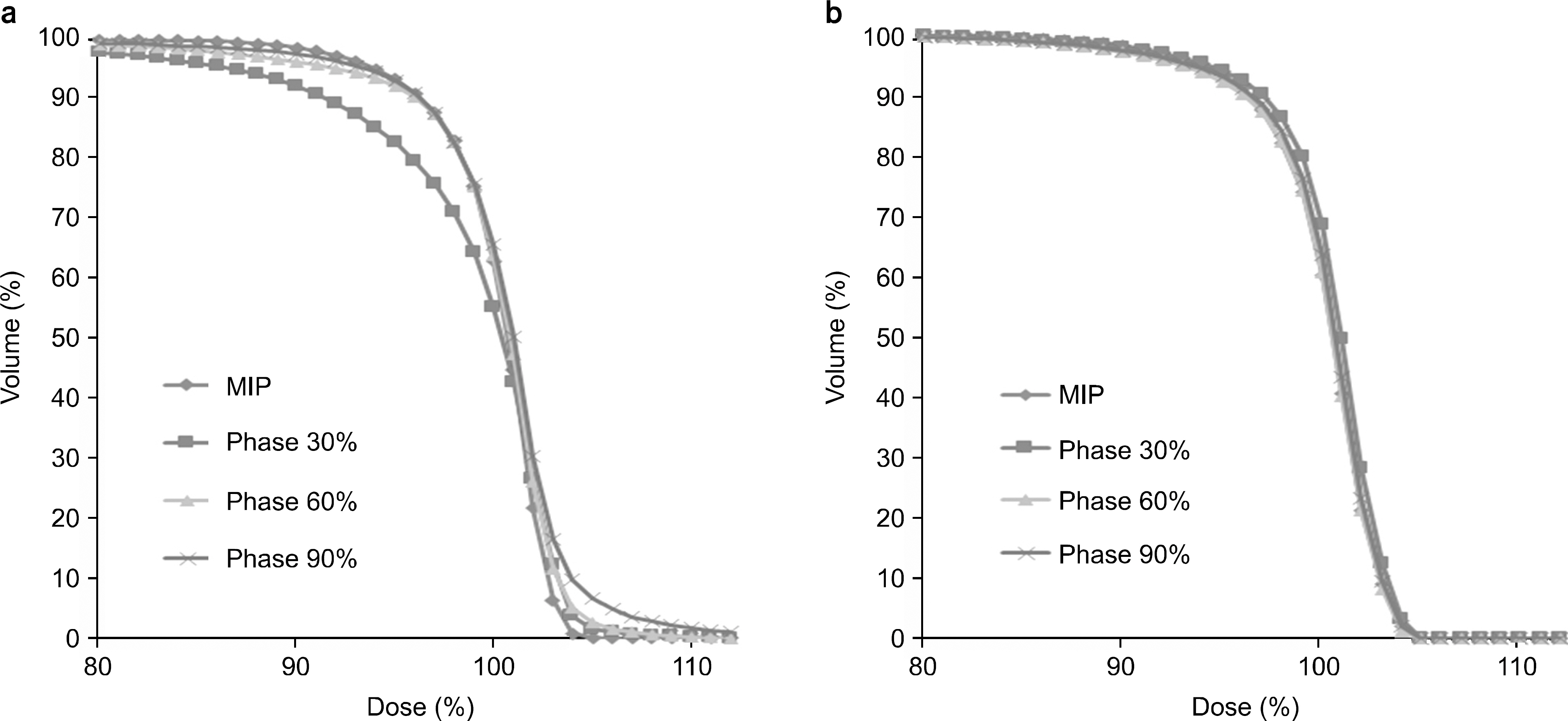Prog Med Phys.
2016 Jun;27(2):93-97. 10.14316/pmp.2016.27.2.93.
Impact of Respiratory Motion on Breast Cancer Intensity-modulated Radiation Therapy
- Affiliations
-
- 1Department of Radiation Oncology, Kyung Hee University Hospital at Gangdong, Seoul, Korea. joocheck@gmail.com
- 2Department of Radiation Oncology, College of Medicine, Kyung Hee University, Seoul, Korea.
- 3Department of Radiation Oncology, Kyung Hee University Hospital, Seoul, Korea.
- KMID: 2328194
- DOI: http://doi.org/10.14316/pmp.2016.27.2.93
Abstract
- In this study, we evaluate the effect of respiration on the dose distribution in patient target volume (PTV) during intensity-modulated radiation therapy (IMRT) and research methods to reduce this impact. The dose distributions, homogeneity index (HI), coverage index (CVI), and conformity index of the PTV, which is calculated from the dose-volume histogram (DVH), are compared between the maximum intensity projection (MIP) image-based plan and other images at respiration phases of 30%, 60% and 90%. In addition, the reducing effect of complication caused by patient respiration is estimated in the case of a bolus and the expended PTV on the skin. The HI is increased by approximately twice, and the CVI is relatively decreased without the bolus at other respiration phases. With the bolus and expended PTV, the change in the dose distribution of the PTV is relatively small with patient respiration. Therefore, the usage of the bolus and expended PTV can be considered as one of the methods to improve the accuracy of IMRT in the treatment of breast cancer patients with respiratory motion.
Keyword
Figure
Reference
-
References
1. Early Breast Cancer Trialists'Collaborative Group.: Effect of radiotherapy after breast-conserving surgery on 10-year recurrence and 15-year breast cancer death: metaanalysis of individual patient data for 10801 women in 17randomized trials. Lancet. 12:1707–1716. 2011.2. Bartelink H, Horiot J and Poortmans P.: Recurrence rates after treatment of breast cancer with standard radiotherapy with or without additional radiation. N Eng J Med. 345:1378–1387. 2011.3. Mukesh M, Branett G, Wilkinson J, Moody A, Wilson C, Dorling L, Hak C, Qian W, Twyman N, Burnet N, Wishart G and Coles C. Randomized controlled trial of intensitymodulated radiotherapy for early breast cancer: 5-years results confirm superior overall cosmesis. J Clin Oncol. 31(36):4488–4495. 2013.4. Joosten A, Matzinger O, Jeanneret-Sozzi W, Bochud F, Moeckli R. Evaluation of organ-specific peripheral does after 2-dimensional, 3-dimensional and hybrid intensity modulated radiation therapy for breast cancer based o monte carlo and convolution/superposition algorithms implications for secondary cancer risk assessment. Radiotherapy and Oncology. 106(1):33–41. 2013.5. Li R, Xing L, Horst KC and Bush K. Nonisocentric treatment strategy for breast radiation therapy: A proof of concept study. Int J Radiat Oncol Biol Phys. 88:920–926. 2014.
Article6. Han E, Paudel N, Sung J, Yoon M, Chung WK and Kim DW. Estimation of the risk of secondary malignancy arising from whole-breast irradiation: comparison of five radiotherapy modalities, including TomoHDA. Oncotarget. 7 (16) (. 2016.7. Kubo H, Hill B. Respiration gated radiotherapy treatment: a technical study. Phys Med Biol. 41(1):83–91. 1996.
Article8. Baglan KL, Sharpe MB, ffray D, Frazier R, Fayad J, Kestin L, Remouchamps V, Martinez A, Wong J and Vicini F. Accelerated partial breast irradiation using 3D conformal radiation therapy (3D-CRT). Int J Radiat Oncol Biol Phys. 55(2):302–311. 2003.
Article9. Pedersen A, Korreman S, Nyström H and Specht L. Breathing adapted radiotherapy of breast cancer: reduction of cardiac and pulmonary doses using voluntary inspiration breath-hold. Radiotherapy and Oncology. 72(1):53–60. 2004.
Article10. Vedam S, Keall P, Kini V and Mohan R. Determining parameters for respiration-gated radiotherapy. Med Phys. 28:2139–2145. 2001.
Article11. Baglan KL, Sharpe MB, ffray D, Frazier R, Fayad J, Kestin L, Remouchamps V, Martinez A, Wong J and Vicini F. Impact of breathing motion on whole breast radiotherapy: a dosimetric analysis using active breathing control. Int J Radiat Oncol Biol Phys. 85(4):1041–1047. 2004.12. Korreman S. Pedersen A, N⊘ttrup T, Specht L and Nyström H: Breathing adapted radiotherapy for breast cancer: Comparison of free breathing gating with the breath-hold technique. Radiotherapy and Oncology. 76(3):311–318. 2005.13. Batra S, Teo K, Vennarini S, Lin LL and Freedman GM. An analysis of 3-dimensional breast motion during normal respiration: What CTV to PTV margin is needed? Int J Radiat Oncol Biol Phys. 87(2):S197. 2013.
Article14. Wu S, Lai Y, HE Z, Zhou Y, Chen S, Dai M, Zhou J, Lin Q and Chi F. Dosimetric comparison of the simultaneous integrated boost in whole-breast irradiation after breast-conserving surgery: IMRT, IMRT plus an electron boost and VMAT. PLoS One. (. 2015.15. Quirk S, Conroy L and Smith WL. Accounting for respiratory motion in partial breast intensitymodulated radiotherapy during treatment planning: A new patient selection metric. Euro J Cancer. 50(11):1872–1879. 2014.16. Amit G and Purdie TG. Automated planning of breast radiotherapy using cone beam imaging. Med Phys. 42:770–779. 2015.17. Feuvret L, Noel G, Mazeron J and Bey P. Conformity index: a review Int J Radiat Oncol Biol Phys. 64:333–342. 2006.18. Paddick I. A simple scoring ratio to index the conformity of radiosurgical treatment plans. Technical note. Journal of neurosurgery. 99:219–222. 2000.
- Full Text Links
- Actions
-
Cited
- CITED
-
- Close
- Share
- Similar articles
-
- Intensity Modulated Radiotherapy and Volumetric Modulated Arc Therapy in the Treatment of Breast Cancer: An Updated Review
- A Dosimetric Comparision of IMRT and VMAT in Synchronous Bilateral Breast Cancer
- Intensity-modulated radiation therapy: a review with a physics perspective
- Introduction of intensity modulated radiation therapy
- Review on the Pre-treatment Quality Assurance for Intensity Modulated Radiation Therapy



